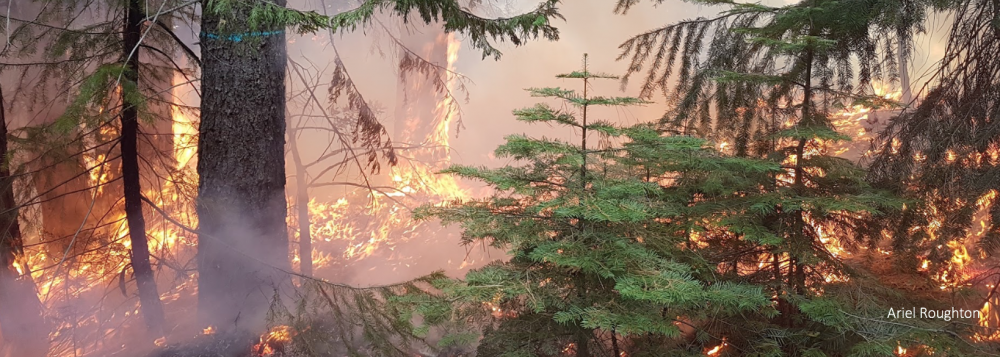
Fire Behavior Modelling
The team has substantial experience in developing and running high-resolution
computational fluid dynamics models including FIRETEC,which is useful in simulating the microclimate and fire-vegetation-atmosphere interaction for a landscape. FIRETEC is a large eddy simulation (LES) tool that can resolve atmospheric turbulence interaction with three-dimensional heterogeneous fuel structures at meter scales and can capture the spread, intensity and extent of burn area under different ignition conditions at 1-2 m resolution. This is
deemed to be an ideal tool to simulate different fuel treatment and ignition scenarios before planning a prescribed fire.The influences of the fire environment, winds, topography and fuel structure on the interaction between multiple lines of fire has not been well characterized, but is a critical issue for robust guidance for prescribed fire practices. FIRETEC will be used to perform this characterization and propose hypotheses that will be tested during prescribed fires as a part of this project.
Air Quality Modeling
By coupling chemical and physical evolution smoke plumes with ambient drivers (combining the strengths of Lagrangian and Eulerian modeling), we will be able to identify air
quality risk hot spots (as influenced by seasonal fire risk and representative meteorological drivers) and evaluate mitigation through Rx fires. Air quality impacts will be predicted for projected burns in areas determined to present significant fire risk. These will be compared with air quality predictions for mitigation scenarios through which Rx fire practices (e.g., burn times, durations, locations; fuel composition and structure; and meteorological conditions) can be optimized to minimize human exposure to Rx burn-related pollution and maximize mitigation of wildfire risk. Using this optimization framework built upon fire risk, fire physics, and smoke emissions and chemistry, air quality considerations of Rx burns can be applied to both historic events and future projections, providing stakeholders with a valuable tool for deciding when, where, and how to apply Rx burn treatments to minimize human health impacts from fire emissions.
Fire Ecology
The emerging field of “pyrosilviculture” involves the combination of traditional silvicultural
practices with developing techniques. Our project will seek to develop the practice of pyrosilviculture in the following ways: (a) Blodgett Forest has a range of forest ages and structures that represent the broad gradient that exists across CA. (b) There is a need to make previous research accessible to the personnel who are to be trained in the use of prescribed fire over the coming decades. (c) A key component of pyrosilviculture is educating the public so that we all become comfortable with the use of fire as a general practice.Field trips will be conducted that will allow students, postdocs and key stakeholders (e.g., media,California Licensed Forester’s Association, Forest Landowners of California, Society of American Foresters, and CA Legislature Tours) to view Rx fire and its effects.
IT and decision support system
IT and decision support system can help transform planning and execution of Rx burns by improving situational awareness using real-time information. Our research explores innovation at two levels. At the physical level, we create a resilient infrastructure that collects and integrates data from diverse sources. At the logical level, we propose techniques to transform the collected data into reliable semantically relevant information for Rx burns. RxFireBase will support observations, analysis of information flows to monitor burn progress (including associated emissions), detect anomalous events and consequently provide guidance to manage the instantiated Rx burn. Our research will explore techniques that can be used at different points in the timeline – before (apriori), during, after burn – to support accurate and up-to-date situational awareness. More specifically, we will explore placement of devices to ignition, monitoring, anomaly detection and mitigation, intelligent data collection, exchange and analysis, as well as explore challenges that arise when the data collected is used to generate semantically meaningful data.
The SPARx project is funded by the UC Multicampus-National Lab Collaborative Research And Training 2020 Awards under the project: Transforming Prescribed Fire Practices for California led by Prof. Tirtha Banerjee, Department of Civil and Environmental Engineering, UC Irvine. It involves collaboration among UC Irvine (lead institute), UC Berkeley, UC Riverside, UC ANR, and Los Alamos National Laboratory.






